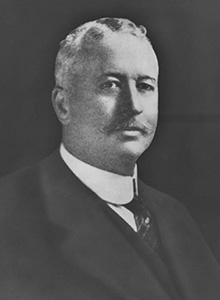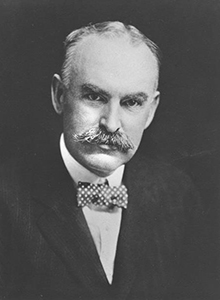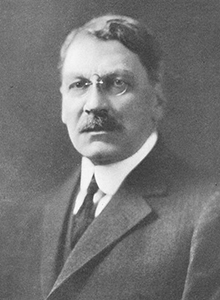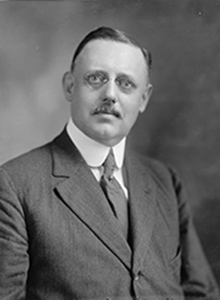
James K. Lynch
- Governor, Federal Reserve Bank of San Francisco, 1917 – 1919
- Born: September 7, 1857
- Died: April 28, 1919
James K. Lynch was appointed governor of the Federal Reserve Bank of San Francisco on August 7, 1917. He died unexpectedly in 1919, at his home in Alameda, California.
Lynch was born in 1857, in San Francisco. A year later his family moved south to San Luis Obispo, California, to run a sheep farm. Lynch returned to San Francisco to attend Boys' High School and stayed in the city for his career. He got his start at age twenty as a bookkeeper for First National Gold Bank, which changed to First National Bank of San Francisco in 1884. He later served as cashier (1894-1904) and ultimately vice president (1904-1917).
In addition to working at First National Bank, Lynch was president of the Citizens' National Bank and the Citizens' Savings Bank of Alameda, vice president of the First National Trust Company of San Francisco, and a director of the First National Bank of Richmond.
Lynch served as vice president and president of the American Bankers' Association, two-time president of the California Bankers' Association, and president of the San Francisco Clearing-house Association.
While vice president of First National Bank of San Francisco, Lynch voiced support for the creation of a US central bank. According to now-defunct publication, Coast Banker, he said, "I have been a believer in a central bank as the best regulator of our affairs since 1907."
However, in 1913, Lynch expressed concern about the Federal Reserve Act. He encouraged fellow members of the American Bankers' Association to attend the upcoming convention in Boston because, he wrote in the July 1913-June 1914 issue of ABA Journal, "hasty and ill advised legislation is being rushed through Congress, which, if passed, must have the most momentous effect upon the banks, and the entire American people. The bankers of the country should voice their disapproval of the objectionable features of the Federal Reserve Act, which include administrative control, note circulation, reserves, excessive capitalization and the compulsion on National banks to contribute capital to the enterprise without adequate return."
The Federal Reserve Act became law on December 23, 1913, and Lynch served on the San Francisco Fed's board of directors from its opening in 1914.
As president of the American Bankers' Association, Lynch rallied bankers at the 1916 Kansas City convention to support the Act. "The Federal Reserve Act," he said, "has made the financial organization of this country possible, and the preliminary steps to that end have already been taken. This, to my mind, is the great reason why the bankers should work with the act and not against it; should try to make it succeed instead of pointing out defects which might cause it to fail, for in doing so they will have not only strengthened the banking system but will have also strengthened the nation."
Lynch was appointed as Archibald Kains' successor in 1917. As second governor of the San Francisco Fed, Lynch was actively involved in promoting the post-World War I Liberty Bond campaigns in the Twelfth Federal Reserve District and drives for war thrift stamps.
After Lynch died, a eulogy in Coast Banker said, "...in the nation as head of the American Bankers Association he did much to lead the bankers of the country in the right way, and the address he made at the Kansas City convention has ever since been regarded as one of the great expositions of financial philosophy in the literature of that association."
Written by the Federal Reserve Bank of San Francisco. See disclaimer and update policy.




 X
X  facebook
facebook
 email
email